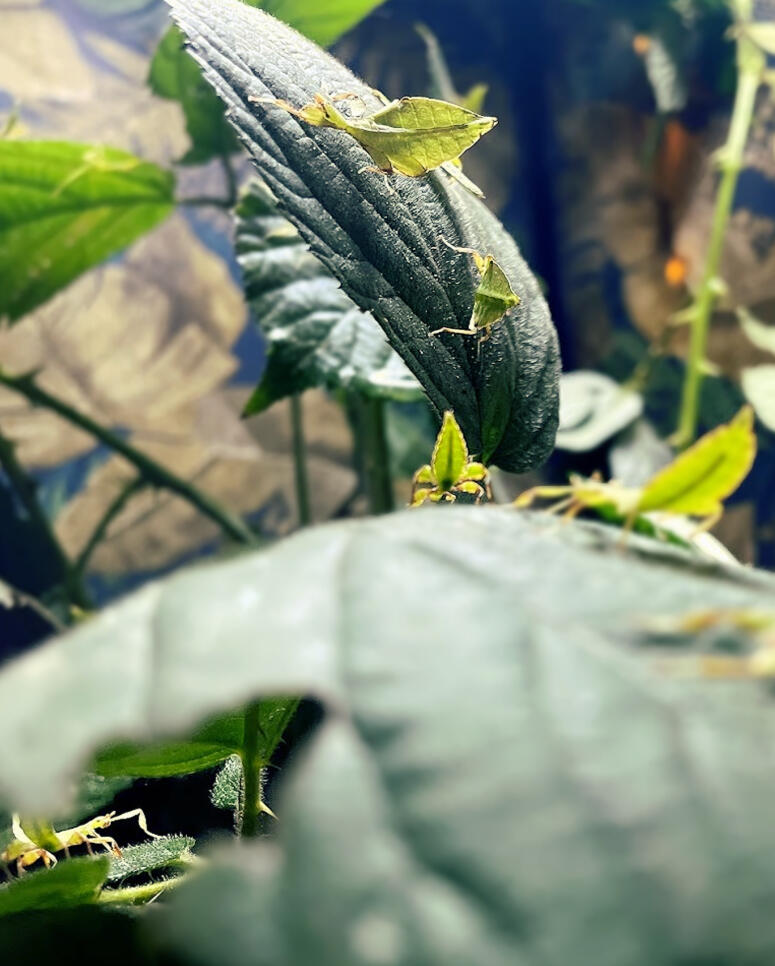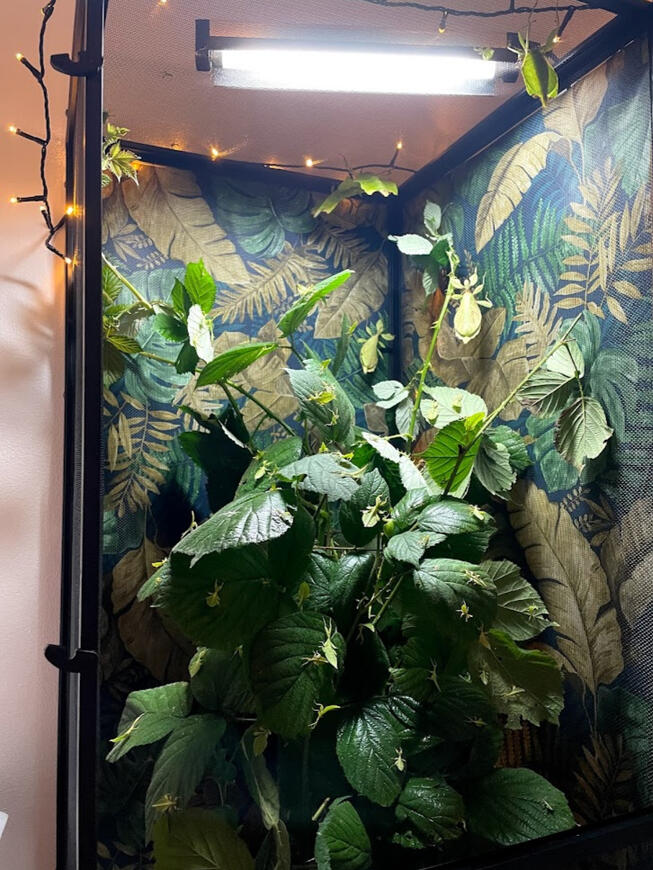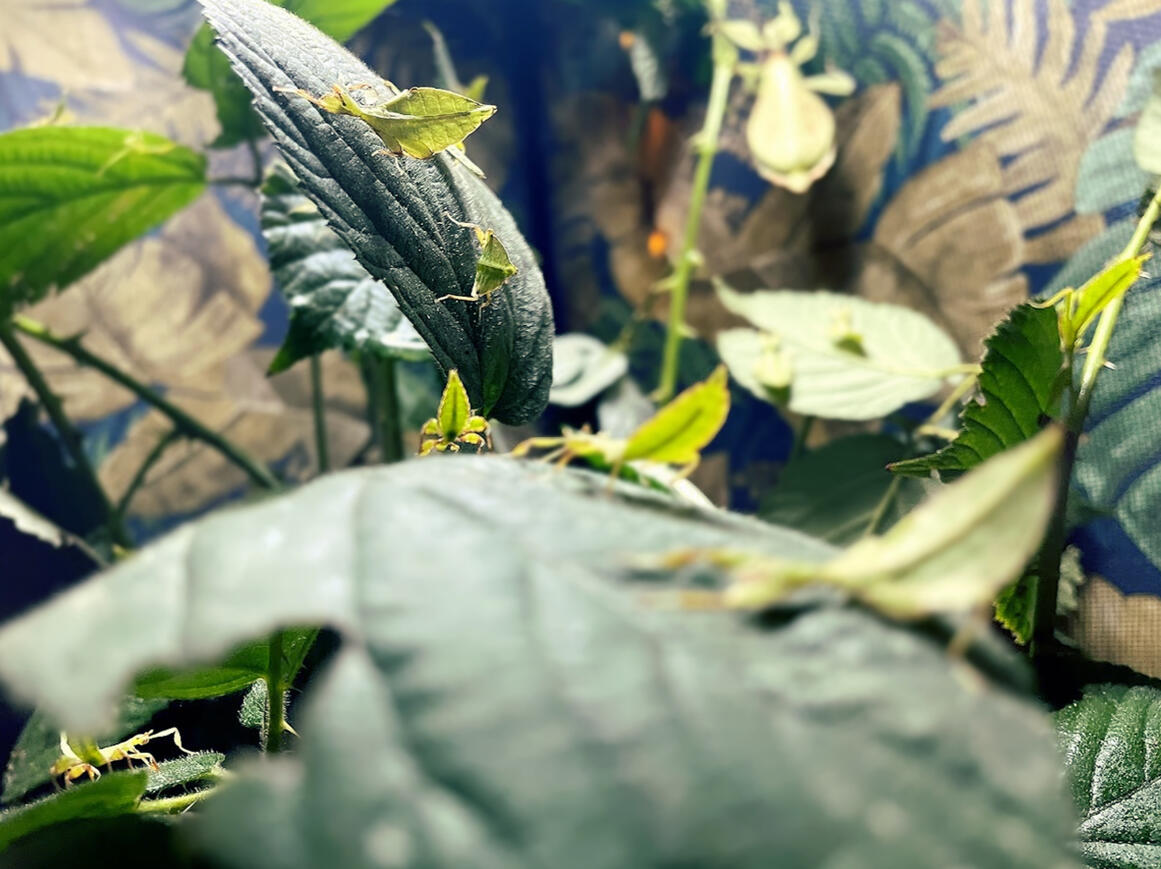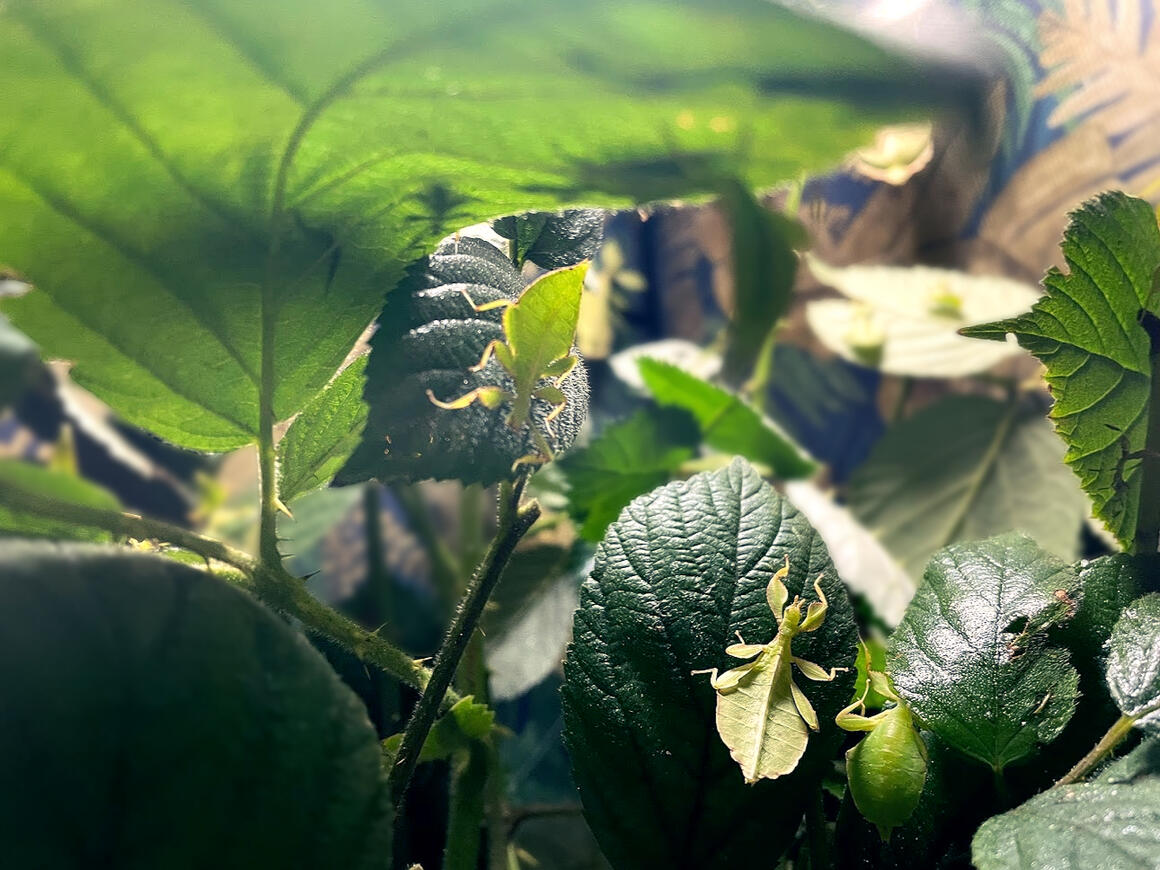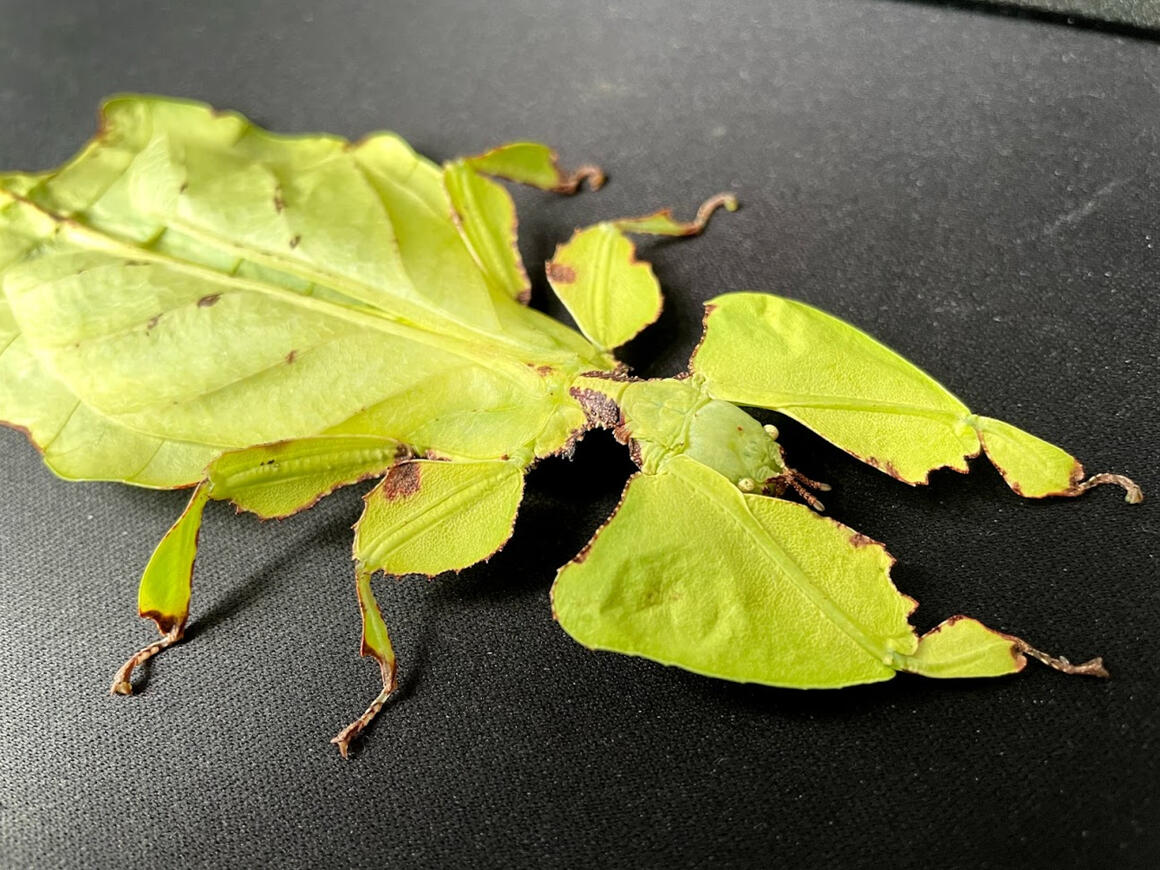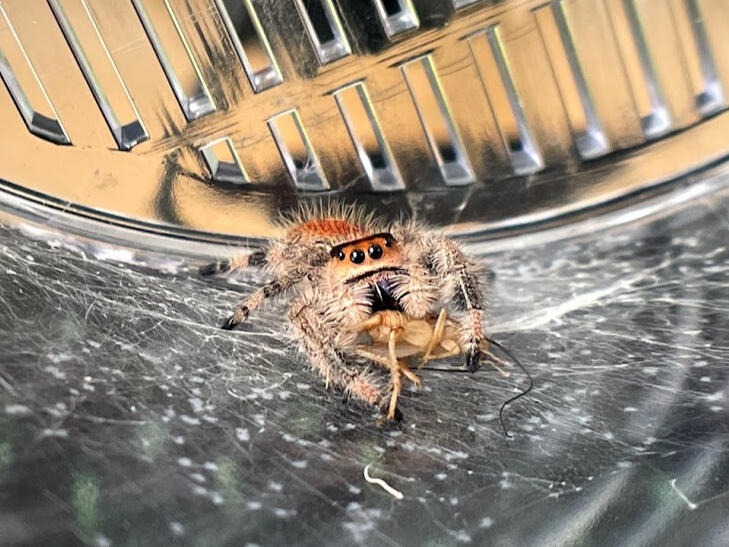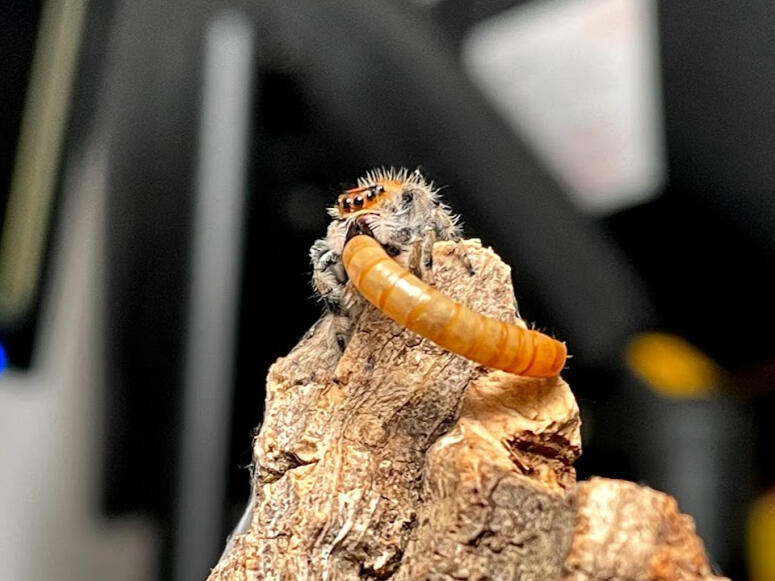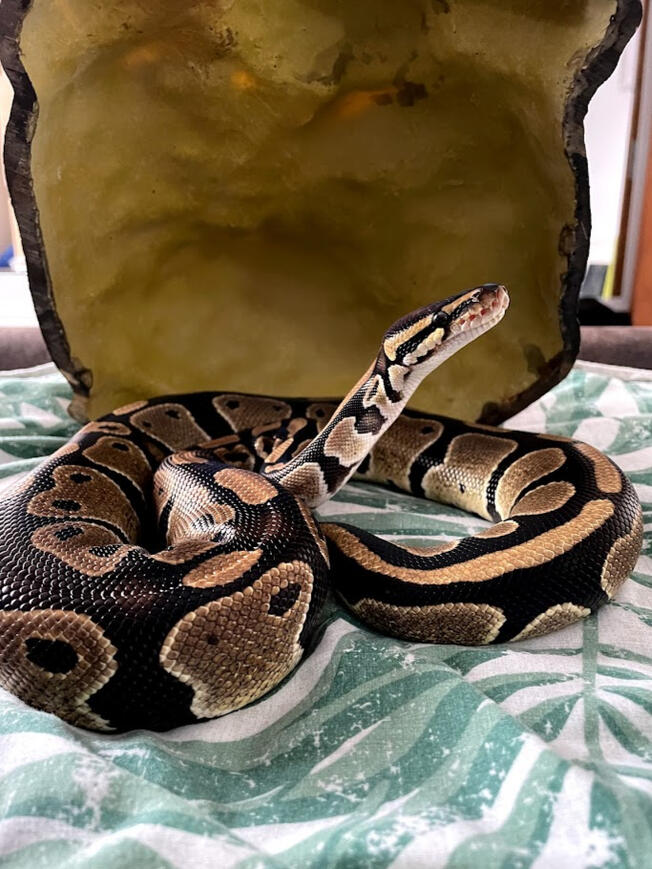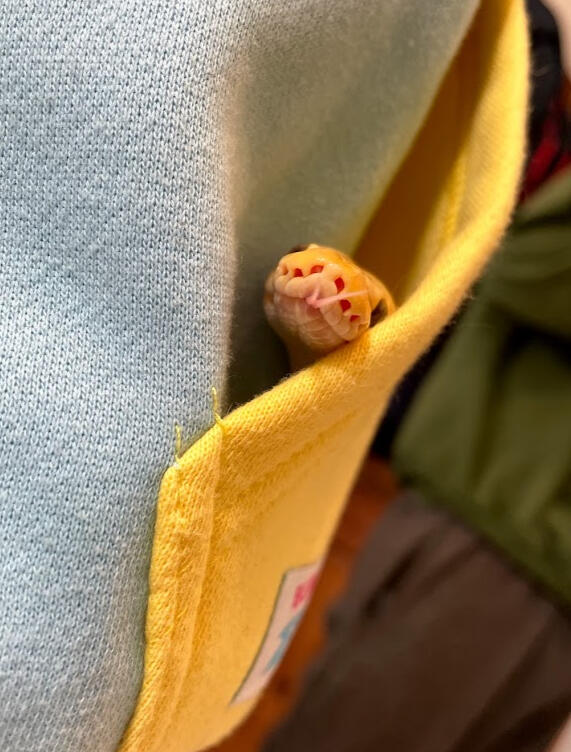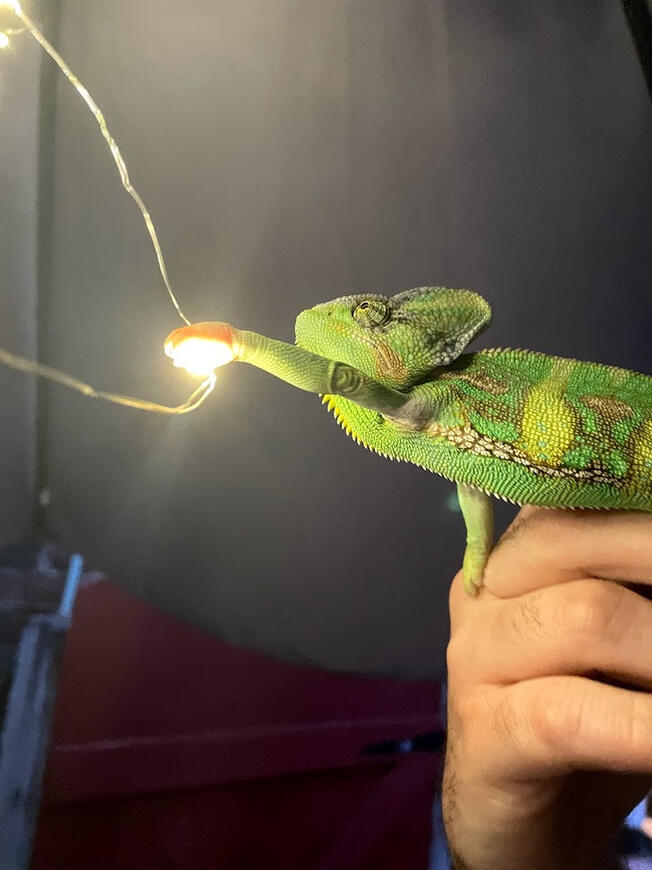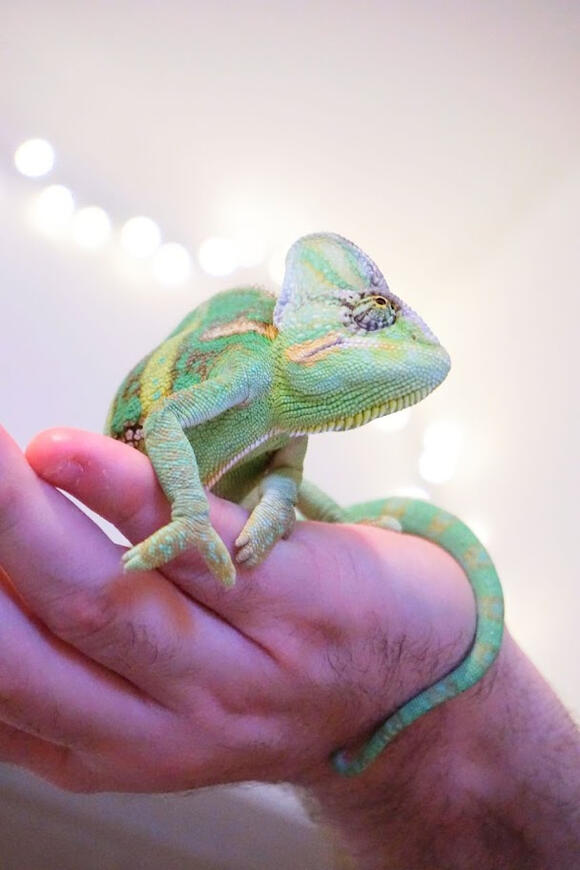
care guides
about

phyllium philippinicum care guide
appearance
Phyllium Philippinicum leaf insects are a species of Phasmid native to the Philippines. They are bright green in colour with a body shaped like a leaf. The body is flat and broad, with brown markings around the rim of the abdomen; they also have veins along the abdomen and wings that replicate a real leaf. The legs are equipped with lobes to also simulate foliage. Primarily bright green, this species is also known to have brown and yellow variants.They can grow quite large, females reaching a size of around 7cm (2¾”) and males around 6cm (2¼”). Although compared to the giant leaf insect, which can reach a size of 11cm (4.3″), they are not that large. The females are larger, thicker and wider than males; they have broad wing covers (Elytra) that lay flat on their abdomen, but lack underwings necessary for flight. Males are thin and slender, they have long antennae and are capable of flight to search out females!The sex of this species can be distinguished from L3 (their third moult), the females bodies are more rounded compared to the males.
behaviour, temperment and handling
Like all phasmids, leaf insects are primarily nocturnal creatures. They do most of their movement and eating at night. They rest motionless between leaves as part of their defence mechanism. Males tend to be more active than females. I have personally found that they do tend to be active during the day, grazing on leaves and moving around the enclosure.They are very docile, but similarly very fragile creatures. Patience is required when handling and caring for these phasmids.The first thing to be told: Many phasmids don’t really like to be handled. So when you try to grab them, they grasp and hold themselves to branches or netting. When they do, don’t pull! A phasmid can quickly lose a leg this way. And even when they can perfectly live without that one leg, it is a bit of a sin. Also, never grab a phasmid by its leg for the same reason.Always take care to wash your hands (without soap) before handling. Also, wash your hands afterwards (this time you may use soap or sanitizer).
enclosure and environmental conditions
EnclosureWhen Nymphs are growing through their first few moults, a medium to large Faunarium is suitable. When they are young they require higher humidities to moult safely and comfortably. Sub-adult to adult insects require a much larger enclosure. The rule of thumb is that the enclosure is at least three times the body height, width of two times the body length. For one adult female this would equate to around 18cms high and 12cms wide. It is always better for the enclosure to be larger rather than smaller.In terms of types of enclosure, Mesh or net is always preferred. This species of Phasmid requires a lot of ventilation. I personally use a large Reptibreeze for my phasmids with paper towels on the base for easy cleanup and egg collection. Some people choose to have a substrate to keep humidity up, but I have found that it is a lot easier to keep clean with paper towels.The decoration in the vivarium should be only the plants they feed on. Anything else will make it harder for them to find food.
TemperaturesPhyllium Philippinicum are from a tropical climate. As such it’s ideal for the temperatures to be between 25c - 30c. They can comfortably live down to around 20c. Room temps are generally fine, though you can use a 50w bulb situated above (not inside) the enclosure - connected to a thermostat - to safely keep the temperature comfortable for them during colder months.
HumiditySimilarly with the temperature, the humidity is best kept higher like it is in tropical climates with lots of rainfall. Ventilation plays a key role for this species, which is why it is preferred to have a mesh or net based enclosure. This helps reduce the chances of mould forming.I personally mist my insects with a ProRep pressure sprayer at least twice a day. This keeps the humidity up which is perfect for easy moulting, whilst also providing a drinking source and keeps the food for them crisp and fresh.The amount you need to spray depends entirely on your setup, if you have substrate and the type of enclosure you keep your phasmids in.
feeding
The primary diet of the Phyllium Philippinicum in our climate is Bramble. This is what I personally feed my phasmids as it is a favourite for them, and can be found year-round in the right locations. New, bright green leaves can be poisonous to phasmids. It is better to feed older, darker leaves that are less bright green.For small nymphs, edges should be cut off to make it easier to eat the leaves.Alternative foods are Oak leaves, Privet, Ivy and Rose leaves. Be mindful if you use these alternate food sources; for example, Rose bushes that are bought in stores will often be sprayed with insecticide.Phasmids need fresh leaves. When you cut off stems with leaves, especially when your enclosure is also warm, they will dry out pretty quickly. To ensure they stay fresh, you’ll need to put them in a vase filled with water. When you do so, just like flower bouquets, the leaves will stay fresh for quite a while. Ensure that the water is not easily accessible as nymphs are prone to drowning.Phasmids also require drinking water. In nature this is provided by the rain and dew. You need to provide this by misting the enclosure, which should be done on at-least a daily basis, if not twice or more a day.
cleaning
Just like cleaning any other pet, you will need to clean the environment your phasmids live in on a regular basis. Phasmids produce a lot of faeces, when not cleaned whilst laying in a humid environment, they will quickly become mouldy and begin to grow bacteria.You can either spot-clean on a daily basis, or choose to deep clean your enclosure at least once a week. When cleaning I will replace the soiled paper towels with fresh ones, and use this opportunity to collect any eggs that will be at the bottom of the enclosure.The water within the vase that holds the foliage should be refreshed at least every other day. This will keep your leaves fresher for longer!If you choose to do a more intensive clean on an enclosure that is acrylic or glass, use only warm water and a bit of elbow grease to remove those droplet marks. Phasmids are fragile creatures and can’t handle the chemicals you would often find in soap and cleaning agents.
life cycle and breeding
The life cycle of Phasmids is a fascinating and interesting process to watch. They start out as eggs and moult 5 to 6 times before becoming full sized adults. An Instar (latin for “form”) is a developmental stage of an insect between each moult until they reach sexual maturity.Instars are often described with the letter L followed by the number of moults the insect has had from hatching. When the phasmid first hatches out of the egg, their instar is L1. With each moult this increases until they become sexually mature.The newly hatched nymphs look nothing like the adult, they are black with white edging and look more alike to a 6-legged spider. During the L1 stage the nymph will gradually turn green before moulting to L2, where it will be entirely green! In some cases, nymphs may lose limbs during the moulting process, but it is possible for them to regrow appendages up until their final Instar!Development of these beautiful phasmids continue until they reach L6 (L5 for males). This is where you will begin to see the pre-stadium for the wings. This would be a sub-adult Phasmid.After the final moult, the adults will be fully developed and sexually mature. The Males will have their wings, be able to fly and have long antennae. The females will have a much thicker abdomen and elytra (wing covers - females have no wings!) that sit beautifully over.In around 2-3 weeks, the females will start laying eggs. On average a female will lay two to three eggs a day which will be dropped to the bottom of the enclosure. Males will often mate with females for long periods of time.Newly laid eggs are smooth and round with an intricate pattern. When exposed to humidity they have small bristles that unfurl and give them the distinctive look. Development times for eggs vary but on average it takes between four to six months to hatch.Phyllium Philippinicum are a parthenogenetic species. They can reproduce asexually, which means that the eggs will be fertile regardless of if a male is present or not. The offspring of asexually produced eggs will look identical to the mother.In terms of keeping the eggs, I store mine in separate containers where the eggs are laid out on paper towels and misted frequently. The hardest part of maintaining eggs is keeping mould away - this will kill the eggs. I choose to wait until the paper towel has dried out before misting again. Other keepers will use coco-fibre or vermiculite, but I find paper towels are easy to monitor and keep clean and overall reduces the chances of mould forming.

phyllium giganteum care guide
appearance
Phyllium Giganteum leaf insects are a species of Phasmid native to Malaysia. They are the largest known leaf insect in the world! The body is flat and broad, primarily green with brown markings around the rim of the abdomen; they also have veins along the abdomen and wings that replicate a real leaf. The forelegs are equipped with extra large lobes to also simulate foliage.As the largest leaf insect, the females reach a size of around 11cm (4.3”) and males around 8cm (3.1”). The females are larger, thicker and wider than males; they have broad wing covers (Elytra) that lay flat on their abdomen, but lack underwings necessary for flight. Males are thin and slender, they have long antennae and are capable of flight to search out females!It was previously thought that there were no males left in this species. There has only been a handful of male specimens that have been documented. As such they can reproduce asexually, which means that the eggs will be viable regardless of if a male is present or not.Here is an article regarding one of two males that have been alive in captivity!
behaviour, temperment and handling
Like all phasmids, leaf insects are primarily nocturnal creatures. They do most of their movement and eating at night. They rest motionless between leaves as part of their defence mechanism. It is hard to coax an adult Giganteum into moving once settled. The nymphs tend to be more hyperactive.They are very docile, but similarly very fragile creatures. Patience is required when handling and caring for these phasmids.The first thing to be told: Many phasmids don’t really like to be handled. So when you try to grab them, they grasp and hold themselves to branches or netting. When they do, don’t pull! A phasmid can quickly lose a leg this way. And even when they can perfectly live without that one leg, it is a bit of a sin. Also, never grab a phasmid by its leg for the same reason.Always take care to wash your hands (without soap) before handling. Also, wash your hands afterwards (this time you may use soap or sanitizer).
enclosure and environmental conditions
EnclosureWhen Nymphs are growing through their first few moults, a medium to large Faunarium is suitable. When they are young they require higher humidities to moult safely and comfortably. Sub-adult to adult insects require a much larger enclosure. The rule of thumb is that the enclosure is at least three times the body height, width of two times the body length. For one adult female this would equate to around 30cms high and 21cms wide. It is always better for the enclosure to be larger rather than smaller.In terms of types of enclosure, Mesh or net is always preferred. This species of Phasmid requires a lot of ventilation. I personally use a large Reptibreeze for my phasmids with paper towels on the base for easy cleanup and egg collection. Some people choose to have a substrate to keep humidity up, but I have found that it is a lot easier to keep clean with paper towels.The decoration in the vivarium should be only the plants they feed on. Anything else will make it harder for them to find food.
TemperaturesPhyllium Giganteum are from a tropical, rainforest climate. As such it’s ideal for the temperatures to be between 25c - 30c. Room temps are generally fine, though you can use a 50w bulb situated above (not inside) the enclosure - connected to a thermostat - to safely keep the temperature comfortable for them during colder months.
HumiditySimilarly with the temperature, the humidity is best kept higher like it is in tropical climates with lots of rainfall. Ventilation plays a key role for this species, which is why it is preferred to have a mesh or net based enclosure. This helps reduce the chances of mould forming.I personally mist my insects with a ProRep pressure sprayer at least twice a day. This keeps the humidity up which is perfect for easy moulting, whilst also providing a drinking source and keeps the food for them crisp and fresh.The amount you need to spray depends entirely on your setup, if you have substrate and the type of enclosure you keep your phasmids in. It can be challenging to keep this species healthy.
feeding
The primary diet of the Phyllium Giganteum in our climate is Bramble. This is what I personally feed my phasmids as it is a favourite for them, and can be found year-round in the right locations. New, bright green leaves can be poisonous to phasmids. It is better to feed older, darker leaves that are less bright green.For small nymphs, edges should be cut off to make it easier to eat the leaves.Alternative foods are Oak and Rose leaves. Be mindful if you use these alternate food sources; for example, Rose bushes that are bought in stores will often be sprayed with insecticide.Phasmids need fresh leaves. When you cut off stems with leaves, especially when your enclosure is also warm, they will dry out pretty quickly. To ensure they stay fresh, you’ll need to put them in a vase filled with water. When you do so, just like flower bouquets, the leaves will stay fresh for quite a while. Ensure that the water is not easily accessible as nymphs are prone to drowning.Phasmids also require drinking water. In nature this is provided by the rain and dew. You need to provide this by misting the enclosure, which should be done on at-least a daily basis, if not twice or more a day.
cleaning
Just like cleaning any other pet, you will need to clean the environment your phasmids live in on a regular basis. Phasmids produce a lot of faeces, when not cleaned whilst laying in a humid environment, they will quickly become mouldy and begin to grow bacteria.You can either spot-clean on a daily basis, or choose to deep clean your enclosure at least once a week. When cleaning I will replace the soiled paper towels with fresh ones, and use this opportunity to collect any eggs that will be at the bottom of the enclosure.The water within the vase that holds the foliage should be refreshed at least every other day. This will keep your leaves fresher for longer!If you choose to do a more intensive clean on an enclosure that is acrylic or glass, use only warm water and a bit of elbow grease to remove those droplet marks. Phasmids are fragile creatures and can’t handle the chemicals you would often find in soap and cleaning agents.
life cycle and breeding
The life cycle of Phasmids is a fascinating and interesting process to watch. They start out as eggs and moult 5 to 6 times before becoming full sized adults. An Instar (latin for “form”) is a developmental stage of an insect between each moult until they reach sexual maturity.Instars are often described with the letter L followed by the number of moults the insect has had from hatching. When the phasmid first hatches out of the egg, their instar is L1. With each moult this increases until they become sexually mature.The newly hatched nymphs look nothing like the adult. They are a dark orange/brown in colouration. In some cases, nymphs may lose limbs during the moulting process, but it is possible for them to regrow appendages up until their final Instar!Development of these beautiful phasmids continue until they reach L6. This is where you will begin to see the pre-stadium for the wings. This would be a sub-adult Phasmid.After the final moult, the adults will be fully developed and sexually mature. They will have a much thicker abdomen and elytra (wing covers - females have no wings!) that sit beautifully over.After a month, the females will start laying eggs. They lay one egg per day which will be dropped to the bottom of the enclosure. Newly laid eggs are smooth and dark with an intricate pattern. Over time they will turn lighter to light brown/grey shade. Development times for eggs vary but on average it takes between six to eight months to hatch. Humidity and lighting affect how quickly the eggs develop.Phyllium Giganteum are a parthenogenetic species. They reproduce asexually, which means that the eggs will be viable despite the fact there is no male present.In terms of keeping the eggs, I store mine in separate containers where the eggs are laid out on paper towels and misted frequently. The hardest part of maintaining eggs is keeping mould away - this will kill the eggs. I choose to wait until the paper towel has dried out before thoroughly misting again. Other keepers will use coco-fibre or vermiculite, but I find paper towels are easy to monitor and keep clean and overall reduces the chances of mould forming. It has been said that keeping these eggs on a day/night cycle helps them develop. Hatching time of the day depends on light. If 10 nymphs hatch in one day, they will all appear within the same hour of the day even if they are hatching in different boxes.

jumping spider care guide
appearance
under construction. please check back soon.
behaviour, temperment and handling
.
enclosure and environmental conditions
Enclosure
...
Temperatures...
Humidity...
feeding
.
cleaning
.
life cycle and breeding
.

species
At Tropic Exotics we are hobbyist breeders of two types of Phasmid (P. Philippinicum and P. Giganteum) and one type of Saltidae (P. Regius). As this is a hobby, we aren't currently expanding though in future we are considering breeding some of our reptiles that have recessive genes.Alongside these inverts, we own various reptiles, including but not limited to a Yemen Chameleon and Royal Pythons. We have experience with exotic animals and will always put the welfare of our pets first.
